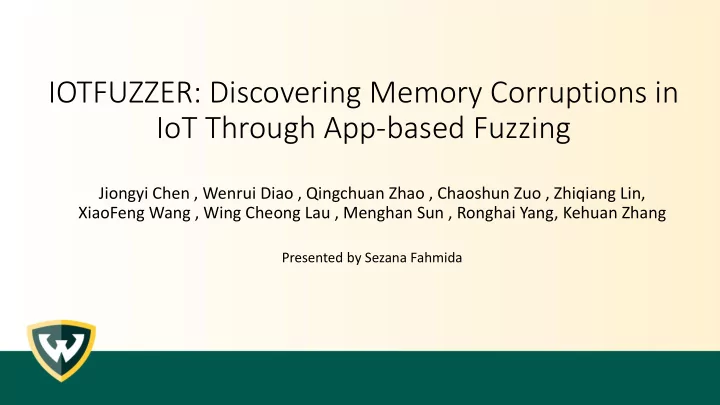

IOTFUZZER: Discovering Memory Corruptions in IoT Through App-based Fuzzing Jiongyi Chen , Wenrui Diao , Qingchuan Zhao , Chaoshun Zuo , Zhiqiang Lin, XiaoFeng Wang , Wing Cheong Lau , Menghan Sun , Ronghai Yang, Kehuan Zhang Presented by Sezana Fahmida
Outline • Introduction • Background • Challenges • Scope & Assumptions • Design • Implementation & Evaluation • Discussion • Conclusion
Introduction • Internet of Things (IoT) dominating the global market • IoT devices is projected to reach 20.4 billion in 2020, forming a global market valued $3 trillion • smart plugs, smart door locks, smart bulbs etc • 2014 to 2016, 90+ independent IoT attack incidents • Targets implementation flaws within a device’s firmware
Background
Typical IoT architecture
Typical IoT architecture • Devices equipped with sensors • Wireless Connection • IoT app to control devices provided by vendors • Communication mode between app and device can be • Direct (wifi/Bluetooth) • Delegated (via a cloud server)
Obstacles in Firmware Analysis • Firmware: Special software providing • System control • Status monitoring • Data collection • Highly customized to fit device architecture • Main Challenges • Firmware Acquisition • Firmware Unpacking • Executable Analysis
Motivation • Skip direct firmware analysis by alternative approach • Intuition: Leverage IoT apps to find vulnerabilities • Advantages: • No need for firmware analysis • Avoids reverse engineering binary executables • Feasable: Most IoT devices use app • Design goal: generate protocol-guided and cryptographic consistent fuzzing messages from IoT apps to find memory corruption
Challenges in IoTFuzzer Design • Mutating fields in networking messages • Device specific protocols are used • Handling encrypted messages • Communication between app and device encrypted • Code obfuscation • Increases complexities • Monitoring crashes • Cannot locally monitor the running process in the system
Solutions • Mutating fields in networking messages • Mutate data at the source • Handling encrypted messages • Reusing cryptographic functions at runtime • Monitoring crashes • Use heartbeat mechanism
Scope & Assumption • IoT devices with apps • Communication channel: Wifi • Direct Connection , No cloud server • Android platform
IoTFuzzer Design • Two phases • App analysis • UI analysis • Data Flow analysis • Fuzzing • Runtime mutation • Response Monitoring
App Analysis Picture taken from author’s slides
App analysis • UI analysis • Static analysis of apk • determine the UI elements that eventually lead to the message delivery • from the target network communication APIs construct the backward code paths to UI event handlers • Activity transition graphs: To find the order of events
App analysis • Data flow analysis • to recognize the protocol fields and record the functions that take these arguments • Dynamic taint tracking • Taint source: string, system API, user input • Taint sink: networking API and encryption functions
Fuzzing
Fuzzing • Runtime Mutation • Dynamic Function Hooking • Intercept function calls and mutate the fuction arguments • Fuzzing Scheduling • Only mutate a subset of function parameters • Fuzzing policy • Changing the lengths of strings • Changing the integer, double or float values • Changing the types or provide empty values
Fuzzing • Response monitoring • Device status inferred from IoT device responses • Expected Response • Unexpected Response – Error is triggered • No Response - Error may be triggered • Disconnected – System crash
Fuzzing • TCP-based connection: look for disconnection • UDP-based connection: send heart-beat message from app
Implementation • 17 representative IoT devices from different categories
Evaluation • 15 serious vulnerabilities (memory corruptions) in 9 devices.
Evaluation
Discussion • Provides high specification coverage, low code coverage • Does not consider cloud relay • cannot generate memory corruption types and root causes directly • final vulnerability confirmation always requires some kinds of manual efforts. • False positives & negatives
Conclusion • IoTFuzzer- first IoT fuzzing framework • Protocol guided fuzzing achieved without protocol specifications
THANK YOU!!!
Recommend
More recommend